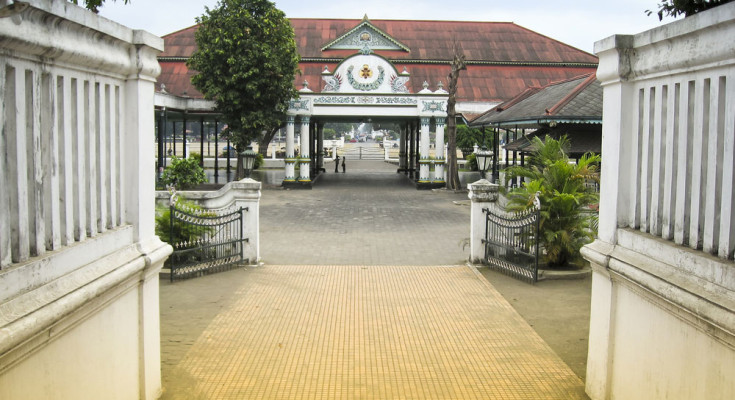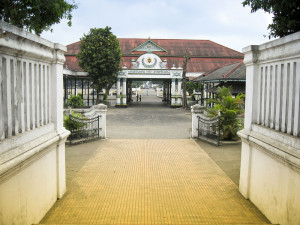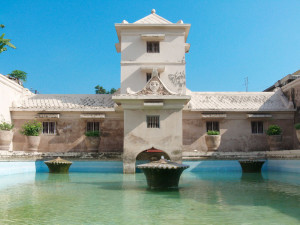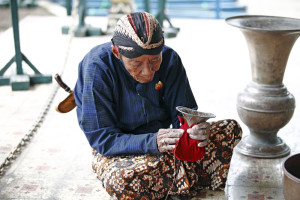By: Rohman Yuliawana
Keraton Yogyakarta is located in the south of the city. The walled complex covers fourteen hectares and consists of dozens of eclectic buildings arranged in a concentric pattern, with the Sultan’s residence in the centre. The layout of the Keraton is based on the Catur Gatra Tunggal (Four in One) philosophy, the unification of the four elements of the kingdom: the Keraton, the mosque, the open field, and the market. The Keraton represents the government, the mosque symbolises religion, the open field denotes the closeness of the king with his subjects, and the market signifies economic activity. A closer look.
“Excuse me, sir. Would please take off your hat?” asked the middle-aged woman who greeted me at the Sri Manganti gateway, the main access for tourists to enter the inner portion of Keraton Yogyakarta (the Palace of the Yogyakarta Sultanate). Several elderly men, wearing jackets made of woven lurik, batik sarung and distinctive Yogyakartan blangkon headdresses, looked in my direction, smiled and nodded. These are the abdi dalem (court retainers), the traditional guardians and caretakers of the Keraton. Under such benign but serious observation, I decided it would indeed be prudent to remove my baseball cap. After all, the heat of the sun wasn’t too scorching in here.
After passing though the gateway, I asked Ibu Sri, my guide for the day, why I had to take off my hat. “Will I be cursed if my head is covered in the Keraton?” I said.
Ibu Sri explained that the removal of hats is a symbol of respect towards the inhabitants of the Keraton. “If the headgear is part of a uniform, like the abdi dalems’, or is a kopiah (Javanese black felt cap) or veil, then it’s alright to wear it,” she explained.
Very idiosyncratic exceptions, I thought. But isn’t it true that idiosyncratic things always have an element of attraction and selling power? Perhaps the essence of tourism is to sell such peculiarities of tradition.
The kingdoms in the Javanese heartland, one of which is the Yogyakarta Sultanate, are the remnants of the dozens or perhaps hundreds of kingdoms that once existed throughout Nusantara. The Keraton Yogyakarta was built two hundred and forty-eight years ago by Prince Mangkubumi Sukowati, an aristocrat from the Islamic kingdom of Mataram, which at that time was centred in Kartasura. Mangkubumi controlled half of the Mataram kingdom after a civil war that lasted from 1746 to1755. This ended bitterly with the splitting of the kingdom into two portions, the Surakarta Kasunanan and the Yogyakarta Sultanate, as set forth in the Treaty of Giyanti in 1755.
To an extent, the Keraton retains the kind of atmosphere that one imagines it must have had all those years ago. Its stubbornness in maintaining feudal relationships, along with the persistence of formal and cultural support from a society otherwise engaged in the drive towards modernisation, has given rise to a seductive exoticism; such a peculiar existence in the twenty-first century attracts attention.
Historically
Historically, tourism in Yogyakarta is indebted to two things: the Keraton and the railroad. The first train station in Yogyakarta was built in Lempuyangan in 1872; it was followed by the larger Tugu Station in 1887. The train services they provided were the catalyst for the development of tourism in Yogyakarta. Ease of access between cities spurred a new interest in group-tours where visitors could witness the enchantingly traditional lifestyle represented by the Keraton. Isaac Groneman, a Dutch doctor who was assigned to the Keraton, observed this trend and, in 1900, published one of the first guidebooks to Yogyakarta. The book promoted, in particular, the Keraton and Tamansari, the recreational garden of the Sultan, which was built in 1758.
Nowadays, around three hundred thousand tourists, both domestic and international, flow through the Keraton’s gates every year. The “Tourist Post”—the outlet run by the Tourist Bureau of the Special Regency of Yogyakarta to handle ticket sales and the co-ordination of guides—claims that between January and September 2004, the total number of tourists who visited the Keraton reached 290,715, of whom 35,848 were foreigners. “Most of them come from European countries, such as the Netherlands, Germany and England. There are only a few Americans; the others are visitors from Japan, Taiwan, Singapore and one or two other places,” said Bu Brahmana, who works at the Tourist Post. According to Bu Brahmana, the number of visitors rises dramatically during the months of January and June, when there can be up to more than 50,000 visitors in a month.
It is not expensive to enter Keraton Yogyakarta and the entrance price includes a guided tour. According to Bu Brahmana, many of the Keraton’s guides are fluent in foreign languages. Several of the guides have studied the history, mythology and philosophical aspects of the Keraton. “Usually, the foreign tourists are more interested in Javanese philosophy and the unusual architecture of the buildings. All the guides must know about these things,” she said.
I did notice, however, a number of guides who were hurrying their visitors along from one location to the next with only quick explanations. It seemed to me that while the tourists were still examining the carvings or collections of objects on display, the guide was already on to the next thing.
Hamengku Buwono VII
Keraton Yogyakarta is located in the south of the city. The walled complex covers fourteen hectares and consists of dozens of eclectic buildings arranged in a concentric pattern, with the Sultan’s residence in the centre. The layout of the Keraton is based on the Catur Gatra Tunggal (Four in One) philosophy, the unification of the four elements of the kingdom: the Keraton, the mosque, the open field, and the market. The Keraton represents the government, the mosque symbolises religion, the open field denotes the closeness of the king with his subjects, and the market signifies economic activity.
Stepping into Keraton Yogyakarta is, indeed, like entering the past. The tourist trail leads from the Sri Manganti Gateway into a sandy courtyard with two pendopo—large, open-sided pavilions with raised tiled roofs, supported by four pillars in the centre and secondary pillars around the outer edge—which are called bangsal. The first pavilion, to the left of the gateway, is named Bangsal Trajumas. This is a showroom of some of the Keraton’s most antique objects, including two bronze gamelan that are said to date from the Majapahit period and two ornate sedan chairs used during the reign of Hamengku Buwono VII.
The other bangsal is named Sri Manganti; it houses a working gamelan, often attended by niyaga (musicians) who accompany the dance performances presented for tourists. The Sri Manganti courtyard is separated from the next courtyard by the Danapratapa Gateway. The symbol of Keraton Yogyakarta, which is known as ‘HaBe’ (composed of the two Javanese letters ‘ha’ and ‘ba’ or ‘HB’ in Latin script)—the abbreviation of the title of the Yogyakarta sultans, Hamengku Buwono—adorns the inner walls. The meaning of the title Hamengku Buwono is, literally, ‘holding the world in his lap’.
On the other side of the gateway, is the larger inner courtyard, the centre of the Keraton, where the most important buildings are situated. Most of these are not open to the public: Gedong Kuning, the Sultan’s residence, and Bangsal Prabayeksa, the most sacred place in the grounds, which houses the Keraton’s most precious and spiritually potent heirlooms and jewels, are both out of bounds. “Absolutely no one may see the heirlooms, except those members of the Keraton who hold the position of bupati or higher,” explained Bu Sri.
Beside Bangsal Prabayeksa, there are two other important buildings: Bangsal Kencana (the Gold Pavilion) and Bangsal Manis (the Sweet Pavilion). Bangsal Manis is used mainly for official dinner parties, while Bangsal Kencana is used for the coronation ceremony of the Sultan and for receiving important guests of the sultanate. “Once, I witnessed Prince Charles and Lady Diana being received there; Hilary Clinton too. Many famous people have been here,” said Bu Sri.
Leaving the inner courtyard, I entered the Sultan Hamengku Buwono IX Museum, which was opened in 1992 by the current Sultan, Hamengku Buwono X. This museum consists of four main buildings, the most important of which is a glass-walled pavilion. The collection it houses presents, in chronological order from childhood to old-age, Sultan Hamengku Buwono IX’s public life in the form of objects such as his official desk and office equipment and original commendations, including his recognition as a National Hero.
Photo collection
Photo by Gwoeii
The second building houses more personal items: the Sultan’s photo collection, recreational accessories, eating utensils and cooking equipment. Also displayed is the diploma the Sultan received from the Department of Literature of Leiden University in the Netherlands. “He was the only Sultan to have received a foreign education. He had an extraordinary number of pastimes; scouting, horseback riding, soccer, photography, cooking,” explained Bu Sri. This is reflected in the range of personal items, such as riding boots and saddle, soccer shoes, several kinds of cameras, and equipment for cooking and making ice cream.
The accoutrements of the Sultan’s throne are exhibited in the next building. Replicas of the palace regalia—the objects which must be present when the Sultan is conducting a ceremony—are arranged around a large portrait of Sultan Hamengku Buwono IX in his royal attire. The original objects, made of gold and decorated with jewels, are kept locked in Bangsal Prabayeksa and are not displayed for visitors.
The final section of the museum houses the Sultan’s various official decorations—ribbons and honorary stars from several nations, as well as the scout uniforms and official suits he wore when he received them. On one wall, there is a portrait of Sultan Hamengku Buwono IX, graced with the words, Tahta Untuk Rakyat (Throne for the People), which was painted by the renowned Yogyakarta batik artist, Amri Yahya. Hanging precariously from a nail is a large photo that shows thousands of people around the funeral carriage that bore the Sultan’s body from the Keraton to the royal burial grounds at Imogiri.
Outside the museum area, there are several more exhibition rooms that seem to receive little attention. Sometimes the guides pass these by, even though they hold interesting collections of crystal glass, old paintings and eating utensils given to the Keraton by foreign royalty; there is even a dining set from Napoleon Bonaparte. In the case near the exit, a number of packages and small bottles of cooking spices have been preserved and displayed. The guides say these spices were the last ones used by the Sultan before he died in 1988.
The guided tour usually ends here, before returning again to the front of the Keraton via the Sri Manganti gateway.
Tourist numbers
As I was on my way out of the gateway, I stopped to chat with one of the abdi dalem. I asked him how he feels about all the tourists passing through. “I’m happy that the Keraton is alive with visitors, but it seems to me that the students don’t pay enough attention,” said Sedya Utomo, an elderly abdi dalem. “Usually, they come in large groups, walking fast and talking loudly.”
Indonesian students make up almost 70% of the total visitors to the Keraton. Pak Utomo prefers visitors who are truly interested in the Keraton’s objects. “I like to see them admiring the exhibits here. It means that they respect our culture,” he said.
“Do tourist numbers affect your income?” I asked him. “No,” he said, “Only guides get tips. Abdi dalem like me only get something if a visitor wants to take a photo with us.”
Sometimes tourists talk with the abdi dalem, but conversations do not add to their wages, which are only Rp 2.500 per month, for working one day in ten. Clearly, they do not work for the money. “The important thing is that I am at peace. Serving like this is not for material benefit, but for spiritual satisfaction,” he explained.
Indeed, the name ‘abdi dalem’ means ‘serving or following the Sultan’. But is spiritual reward enough? “What more is there? That’s all the Keraton can provide so far,” said Pak Utomo.
This attitude of pasrah, or submission, should be added to the long list of prerequisites demanded of these loyal retainers. Perhaps it is inappropriate, though, to compare the choice of becoming an abdi dalem—whose basic orientation is to seek spiritual satisfaction—with the formal professions of today. According to Pak Utomo, many of the present abdi dalem are anxious because of their difficulty in finding new recruits from the younger generation. The respect and prestige that the older generation of abdi dalem enjoy as a result of their connection to the Keraton seems to be lost on them. “It is rare now that young people are interested in spiritual vocations,” he said.
There are two main public perceptions of the Keraton: one is that it is a ‘living museum’, frozen in the past for the benefit of tourism; the other is a genuinely enthusiastic acknowledgement of the Keraton’s enduring cultural and spiritual charisma. The image of millions of mourning people, filling the streets along the seventeen kilometres between Yogyakarta and Imogiri to witness the funeral procession of Sultan Hamengku Buwono IX in 1988, remains clear in the memories of many Yogyakartans. Ten years later, one million people turned out to walk through Yogyakarta to the Keraton to support Sultan Hamengku Buwono X in demanding the end of the New Order regime.
The myths, rules and rituals that surround the Keraton have given it an air of mystery, but they also give continuing legitimacy to the role of the Keraton authorities in Yogyakarta civic life. Now that the Keraton authorities have been stripped of real political power, though, should the trappings of power still be maintained? Are the abdi dalem, for instance, being used to perfect the “theatrical performance” of a traditional Javanese kingdom? I didn’t find any simple answers at Keraton Yogyakarta.
(First published in Latitudes Magazine)















What a great article ! There’s so much culture and history behind these places and traditions. My wife is from Central Java. I hope I can visit the graves of the kings one day soon, Mataram and Hamengkubuwono. Thanks !!!